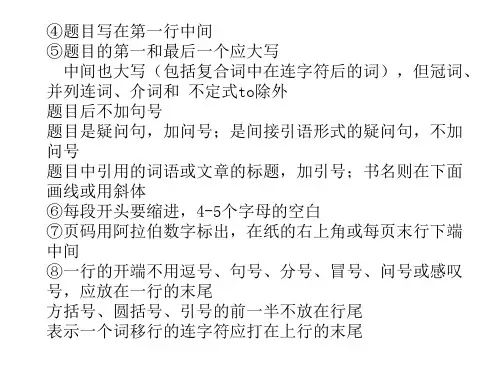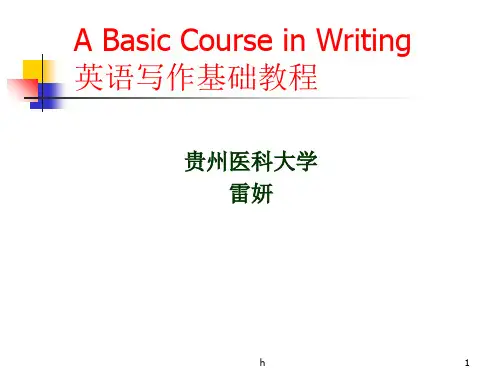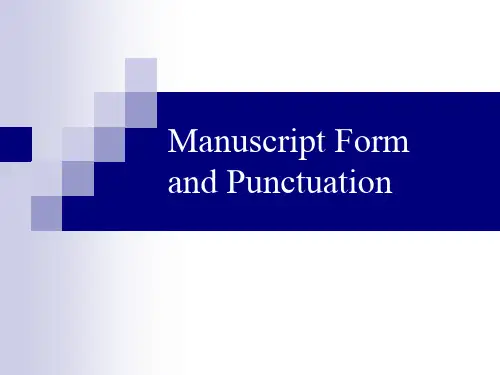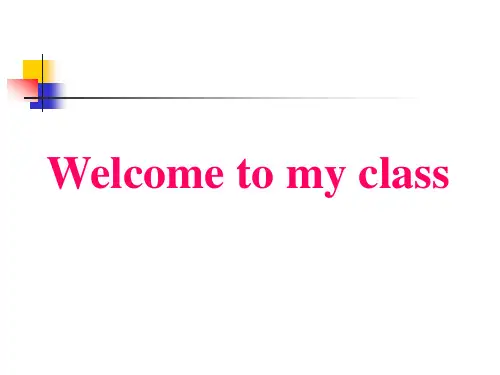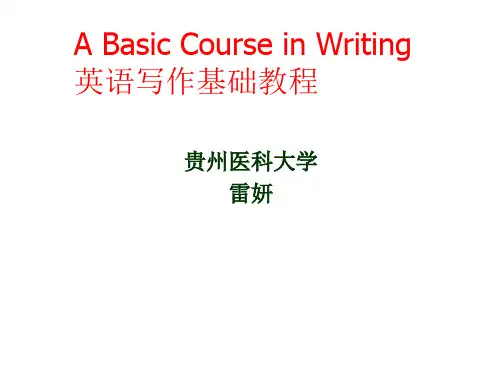2.Word Division
- 格式:ppt
- 大小:44.00 KB
- 文档页数:2
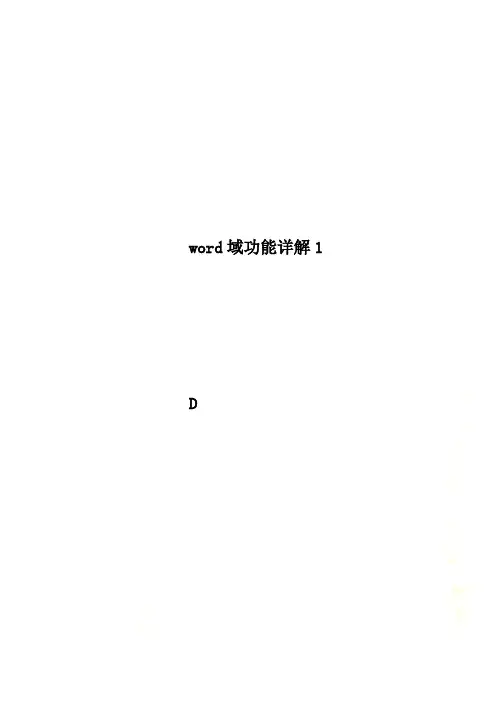
word域功能详解1 D用途:将段落顺序编号。
选项:开关说明:\s 定义分隔字符(2)AutoNumLgl域语法:{ AUTONUMLGL [Switches] }用途:对法律和技术类出版物自动进行段落编号。
选项:开关意义:\e 显示无句点的法律式编号(3)AutoNumOut域语法:{ AUTONUMOUT }用途:自动以大纲样式对段落进行编号。
(4)Barcode域语法:{ BARCODE \u "LiteralText" 或Bookmark \b [Switches ] }用途:插入邮政条码(美国邮政局使用的机器可读地址形式)。
它既可以插入POSTNET(收信人点条码),也可以插入“外表识别标记”(或称为FIM)。
选项:指令意义:"LiteralText" 或Bookmark 收信人地址和邮政编码。
后面跟\b开关时,书签可以替代LiteralText。
另外,LiteralText也可以是嵌套域的结果开关说明:\b 前接一个书签时,使用书签定义的地址中的邮政编码信息\f "letter" 插入“外表识别标记”(FIM),由字母指定回邮标记的类型:"A"插入一个礼节性回邮标记;"C" 插入一个商业回邮标记。
要打印FIM-A和FIM-C标记,必须有POSTNET 条码\u 表示条码是美国的邮政地址(5)Bookmark和Ref域语法:{ [REF] Bookmark [Switches] }用途:插入指定的书签所代表的文字或图形,而且活动文档中必须有该书签的定义。
要插入其他文档中的用书签标记的文字或图形,可以使用INCL?PICTURE或INCL?TEXT域。
选项:指令意义:Bookmark 书签名。
如果书签所标记的文字包含段落标记,则BOOKMARK域之前的文字将使用书签中段落的格式开关说明:\f 增加书签所标记的脚注、尾注或批注序号并插入对应的注释或批注文字\h 创建到用书签标记的段落的超级链接\n 域将以无后续句点形式显示交叉引用段落的完整的段落编号\p 使域使用“见上方”或“见下方”形式显示其相对于源书签的位置\r 将书签标记段落的无后续句点形式的完整段落编号插入相关文字或相对于编号方案中的位置\t 与\n、\r 或\w开关连用时,使REF域屏蔽非分隔符或非数字文字\w 插入用书签标记的段落的段落编号,此编号会反映该段落在文档全部上下文中的位置(6)ListNum域语法:{ LISTNUM "Name" [Switches] }用途:在段落中的任意位置插入一组编号。
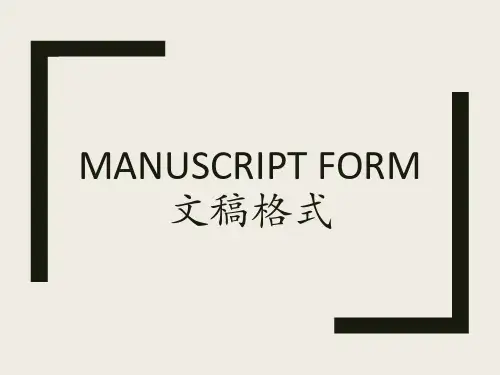
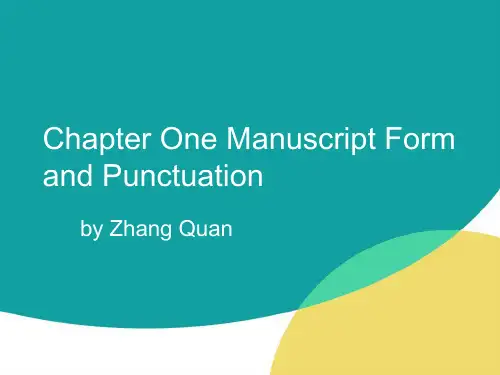
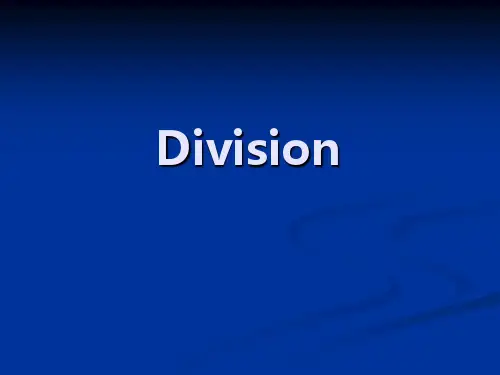
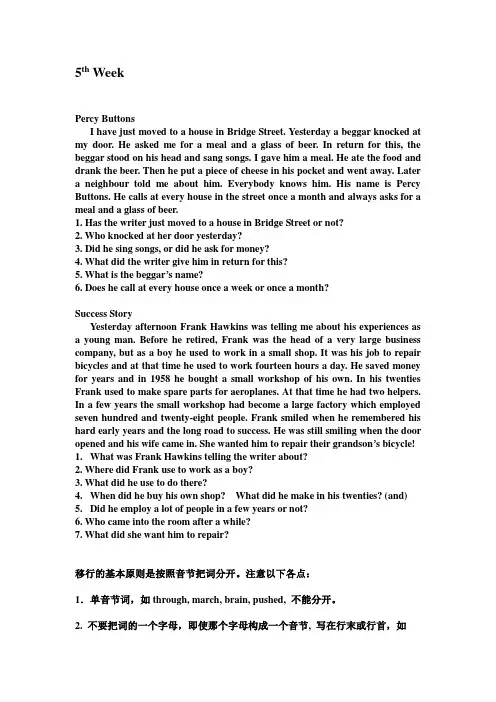
5th WeekPercy ButtonsI have just moved to a house in Bridge Street. Yesterday a beggar knocked at my door. He asked me for a meal and a glass of beer. In return for this, the beggar stood on his head and sang songs. I gave him a meal. He ate the food and drank the beer. Then he put a piece of cheese in his pocket and went away. Later a neighbour told me about him. Everybody knows him. His name is Percy Buttons. He calls at every house in the street once a month and always asks for a meal and a glass of beer.1. Has the writer just moved to a house in Bridge Street or not?2. Who knocked at her door yesterday?3. Did he sing songs, or did he ask for money?4. What did the writer give him in return for this?5. What is the beggar’s name?6. Does he call at every house once a week or once a month?Success StoryYesterday afternoon Frank Hawkins was telling me about his experiences as a young man. Before he retired, Frank was the head of a very large business company, but as a boy he used to work in a small shop. It was his job to repair bicycles and at that time he used to work fourteen hours a day. He saved money for years and in 1958 he bought a small workshop of his own. In his twenties Frank used to make spare parts for aeroplanes. At that time he had two helpers. In a few years the small workshop had become a large factory which employed seven hundred and twenty-eight people. Frank smiled when he remembered his hard early years and the long road to success. He was still smiling when the door opened and his wife came in. She wanted him to repair their grandson’s bicycle!1.What was Frank Hawkins telling the writer about?2. Where did Frank use to work as a boy?3. What did he use to do there?4.When did he buy his own shop? What did he make in his twenties? (and)5.Did he employ a lot of people in a few years or not?6. Who came into the room after a while?7. What did she want him to repair?移行的基本原则是按照音节把词分开。
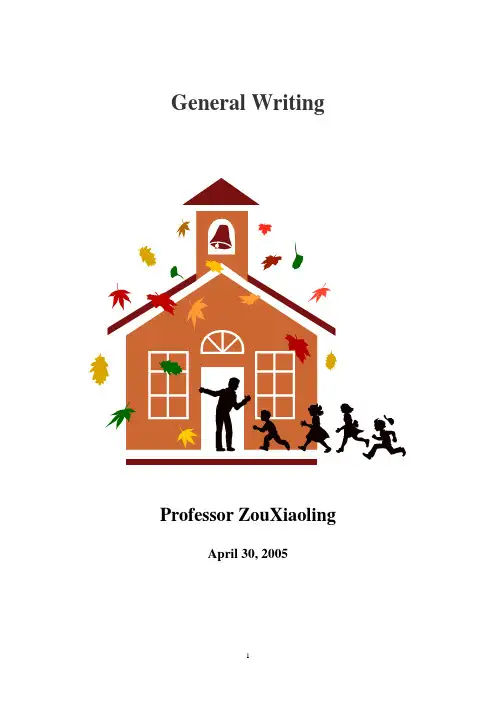
General WritingProfessor ZouXiaolingApril 30, 2005Teaching Plan for WritingParticipants: Third-year StudentsTime: 9/2003-6/2004General Goals or Objectives:▼try to improve students’ writing ability through classes and writing materials▼Students acquisition of the skills involved through writing practice▼Enlarge students’ horizon in writing through reading, translating and writing practiceMajor Task of each Semester◆the first term: basic writing◆the second term: applied writingI. the basic writing rules●Manuscript Form: When we write we should work carefully, write neatly and clearly; proofread it once or twice.1. Arrangement: How do we write the title? Where, what kind of words, punctuation rules.2. Word Divisi on rules: Who’d like to list the word division rules in writing? When do it, pay attention tosyllables and the form of the word.3. Capitalization rules: When do we use capitalization?4. Punctuation (for general rules): What kinds of Punctuations are usually used in writing?5. Handwriting:1> What should we do when we want to cross out a word?2> What should we do when we write a word in wrong spelling:3> What should we do when we want to add a word:4> Write letters clearly:●Diction (the choice and use of words)1. Words1> levels of words:2> meaning of words:3> general and specific words:2. Idioms:3. Figures of speech:●The Sentence1. Complete sentences and sentence fragments:2. Types of Sentences.1>According to their use, sentences can be divided into declarative, interrogative, imperative and exclamatory ones.2>According to the structure, sentences can be divided into simple, compound, complex and compound-complex ones.3>Short and long sentences.3. Effective sentences.1> Unity:2>Coherence:3> Conciseness:4> Emphasis:The Paragraph1. Effective paragraphs:(1) Unity:(2) Coherence:(3) Transition:2. Ways of developing paragraphs.1> Development by time.2> Development by process.3> Development by space.4> Development by example or generalization.5> Development by comparison and contrast.6> Development by cause and effect.7> Development by classification.II . Steps in Writing a Composition1. Use the example “The Sc hool Library” to explain the following point.1. Assemble your ideas:2. Work out your thesis3. Make an outline4. Write the First Draft5. Revise the First Draft6. Making the Final Copy2. Exercises:Suppose the topics assigned are:1. Chinese young people of the 20th century2. A familiar professor (Our English teacher)3. Appearances are deceptiveA. Write down 12~15 relevant points.B. According to the points you have written, formulate three possible theses.C. Choose one thesis which you consider most suitable.D. Work out an outline.II. Organizationment on students’ exercisesanization1.Some Principles: 1) Unity: 2) Coherence: 3) Richness: 4) Proportion:2.The beginning: give students some sentence patterns to begin a composition3.The End: give students some sentence patterns to end a composition3. Exercise:1) Write a beginning paragraph using any of the sentence patterns listed above for one of the following topics:● 1. College Education; 2. Private Schools; 3. The importance of self-education; 4. Premature Preschool Education● 1. Morality and Education; 2.Two Educational Patterns; 3. Children’s Education; 4. Students’ part-time jobs;5. The Changing Criteria of a Good Student;6. Studying Abroad;7. Psychological Health● 1. Can Test Tell the Whole Story; 2. On Cheating in Examinations; 3. On grading system; 4. On Test and Test Cheating; Should Class Attendance be Required● 1. A Good Teacher; If I were a Teacher● 1. Social Practice; 2. Social activities and our study; 3. Make Full Use of School Days; 4. The Impact of Commercial Awareness on Higher School Education● 1. Youth is a Golden Age; 2. Preciousness of Time; 3. The value of Time● 1. Failure and Success; 2. On Failure; 3. Key Factors to Success● 1. It is Never Too Old to Learn; 2. On Diligence; 3. Fair Competition● 1. Books and Teenagers; 2. The Importance of Extensive Reading; 3. The Good of Reading Books; 4. Reading Makes a Full Man● 1. Work and Recreation; 2. Recreation; 3. Work and Play; 4. How to Spend Leisure Time; 5. Holiday Ideas are Changing; 6. Interests; 7. Hobbies; 8.Teacher Doing Business; 9. Music● 1. The Right Use of Money; 2. Temptation; 3. Talent and Wealth; 4. Wealth and Happiness; 5. Things Making Life Happy● 1. The One Child Family; 2. Overpopulation; 3. China’s Unem ployment Today; 4. The Career I Pursue; 5. Birth Control: Key to China’s Development● 1. On Open Policy; 2. The Importance of Agriculture; 3. China’s Market Economy; 4. Combating Fake Goods; 5. The Favorable Effects of Tourism; 6. Business Ethics● 1. Discount; 2. Is TV a Plus or a Minus; 3. Pets; 4. TV Shopping; 5. News Media; 6. Different Social Customs Between Americans and Chinese; 7. Liberty; 8. Mercy Killing (Euthanasia); 9. Video Games; 10. Shortening Work week● 1. Fast Food in China; 2. Fast-Food Restaurants● 1. Man and Environment; 2. How to Save the Wild; 3. Why Do Some Animals Die Out; 4. The Advantages and Disadvantages of Tall Buildings; 5. World’s Urbanization; 6. Housing Problems in Cities; 7. Preserving the Environment; 8. Make Cities Greener; 9. Copyright; 10. Intellectual Property Right; 11. Culture Shock; 12. Globalization● 1. What Modern Sports Bring About; 2. Participating is Most Important; 3. How to Keep Fit; 4. How to Get Rid of Bad Habits● 1. The importance of Science and Technology in Modern Life; 2. Science and Human Life; 3. Science and the Problem in the World; 4. Hopes and Fears of the Future; 5. Computer Technology● 1. Water Resources; 2. Natural Resources; 3. China’s Energy; 4. Solar Energy; 5. Energy Crisis; 6. An Effective Way to Conserve Resource---Recycle● 1. Thrift; 2. Honesty; 3. Modesty; 4. Patriotism; 5. Patience; 6. The Importance of Confidence; 7. Creativity ● 1. Talent and Diligence; 2. Diligence and Success; 3. Competition and Cooperation; 4. Choosing the Right Career; 5. Career Planning● 1. Love; 2. Love and Marriage; 3. My View on Family; My Home● 1. Opportunity and Success; 2. Fate; 3. Opportunity; 4. My View on Opportunity● 1. The origin of the Dragon Boat Festival; 2. The Most Memorable Day in My Life; 3. My father (or Mother);4. A Friend in My Memory;5. My First Day on the Campus2) Write an ending paragraph using any of the sentence patterns listed above for one of the following topics:● 1. College Education; 2. Private Schools; 3. The importance of self-education; 4. Premature Preschool Education● 1. Morality and Education; 2.Two Educational Patterns; 3. Children’s Education; 4. Students’ part-time jobs;5. The Changing Criteria of a Good Student;6. Studying Abroad;7. Psychological Health● 1. Can Test Tell the Whole Story; 2. On Cheating in Examinations; 3. On grading system; 4. On Test and Test Cheating; Should Class Attendance be Required● 1. A Good Teacher; If I were a Teacher● 1. Social Practice; 2. Social activities and our study; 3. Make Full Use of School Days; 4. The Impact of Commercial Awareness on Higher School Education● 1. Youth is a Golden Age; 2. Preciousness of Time; 3. The value of Time● 1. Failure and Success; 2. On Failure; 3. Key Factors to Success● 1. It is Never Too Old to Learn; 2. On Diligence; 3. Fair Competition● 1. Books and Teenagers; 2. The Importance of Extensive Reading; 3. The Good of Reading Books; 4. Reading Makes a Full Man● 1. Work and Recreation; 2. Recreation; 3. Work and Play; 4. How to Spend Leisure Time; 5. Holiday Ideas are Changing; 6. Interests; 7. Hobbies; 8.Teacher Doing Business; 9. Music● 1. The Right Use of Money; 2. Temptation; 3. Talent and Wealth; 4. Wealth and Happiness; 5. Things Making Life Happy● 1. The One Child Family; 2. Overpopulation; 3. China’s Unemployment Today; 4. The Caree r I Pursue; 5. Birth Control: Key to China’s Development● 1. On Open Policy; 2. The Importance of Agriculture; 3. China’s Market Economy; 4. Combating Fake Goods; 5. The Favorable Effects of Tourism; 6. Business Ethics● 1. Discount; 2. Is TV a Plus or a Minus; 3. Pets; 4. TV Shopping; 5. News Media; 6. Different Social Customs Between Americans and Chinese; 7. Liberty; 8. Mercy Killing (Euthanasia); 9. Video Games; 10. Shortening Work week● 1. Fast Food in China; 2. Fast-Food Restaurants● 1. Man and Environment; 2. How to Save the Wild; 3. Why Do Some Animals Die Out; 4. The Advantages and Disadvantages of Tall Buildings; 5. World’s Urbanization; 6. Housing Problems in Cities; 7. Preserving the Environment; 8. Make Cities Greener; 9. Copyright; 10. Intellectual Property Right; 11. Culture Shock; 12. Globalization● 1. What Modern Sports Bring About; 2. Participating is Most Important; 3. How to Keep Fit; 4. How to Get Rid of Bad Habits● 1. The importance of Science and Technology in Modern Life; 2. Science and Human Life; 3. Science and the Problem in the World; 4. Hopes and Fears of the Future; 5. Computer Technology● 1. Water Resources; 2. Natural Resources; 3. China’s Energy; 4. Solar Energy; 5. Energy Crisis; 6. An Effective Way to Conserve Resource---Recycle● 1. Thrift; 2. Honesty; 3. Modesty; 4. Patriotism; 5. Patience; 6. The Importance of Confidence; 7. Creativity ● 1. Talent and Diligence; 2. Diligence and Success; 3. Competition and Cooperation; 4. Choosing the Right Career; 5. Career Planning● 1. Love; 2. Love and Marriage; 3. My View on Family; My Home● 1. Opportunity and Success; 2. Fate; 3. Opportunity; 4. My View on Opportunity● 1. The origin of the Dragon Boat Festival; 2. The Most Memorable Day in My Life; 3. My father (or Mother);4. A Friend in My Memory;5. My First Day on the CampusIII. Types of Writing1.Description: Description is painting a picture in words of a person, place, object, or scene. Give some models to explain the following.(1)Description of a personExercises:1) Read the model essays and discuss what main impressions each writer wishes to give of the person described.2) Describe a person. The person may be(1) some one you know well, such as a family member, a relative, a teacher or a classmate, a colleague or a friend;(2) some stranger who attracted your attention and made a deep impression on you;(3) some character in a book, a film or a TV show;(4) yourself.Be sure to give well chosen details of the person's appearance, character, behavior or whatever worth mentioning. Do not write in generalities but focus on one or two aspects and try to “show" by examples instead of "tell" in words --- note how Kissinger uses the example of the young interpreter to show Chinese people's love for PremierChou Enlai(2)Description of a placeExercises:1) Read the model essays and discuss the devices used by the authors, the impressions they create and the purposes of description.2) Describe a place. It may be(1) a scenic spot, a park, a garden, a theater, a market-place, a shopping center, a hotel lobby, an exhibition, a flower show, a museum, etc.;(2) a Siheyuan, a compound with houses around a courtyard, in Beijing;(3) someone's study, bedroom, living-room, kitchen, etc.3) Describe a dormitory of four students to show that A is neat and tidy and time-conscious, B is warm-hearted and loves sports, C is a careless music lover, and D is more interested in fashions than in his or her studies.(3)Description of an objectExercises:1) Read the model essay and discuss the devices the author uses and his purpose of description.2) Describe an object. It may be(1) a painting, an old photo, an article of handcraft art, a tablet, a tombstone, etc.(2) an exhibit in a museum or an exhibition, such as an unearthed artifact, a new product or household gadget;(3) an ancient Chinese invention such as the earliest compass;(4) a Pailou (a free-standing arch), or any other example of Chinese architecture;(5) a cloud pillar, a stone lion, or other examples of culture-loaded objects.(4)Description of a sceneExercises:1) Read the model essays and comment on the dominant impressions they give the reader and how these impressions are created through the setting, the people and the actions.2) Describe a scene. It may be(1) a (birthday) party, a celebration, a wedding, a demonstration, an accident, etc.(2) someone's homecoming or departure.Decide on the effect(s) you want to achieve before you begin so that your essay will include only the relevant details.3) Write a description of1. how people celebrate the Mid-autumn or Spring Festival in your home town;2. some special custom of the Han nationality or any of the minority nationalities in China.4) Choose your own topic and write a description of a person, place, object, or scene.2. Narration(1) Context(2)Selection of details(3)Organization(4)Point of view(5)PurposeExercises:I . Read the model essays carefully and discuss:1. Have the authors made clear when, where, and to whom the action in the narrative happened at the beginning?2 What is the purpose of each story?3 Are the details selected useful and effective?4. How are the events organized?5. Can the three first-person narratives be changed into third-person narratives? What are the advantages and disadvantages of the change?II. Write a first-person narrative describing1. the happiest or saddest or most memorable or most important day in your life, for example, your first day at school, the day when you were given an interview, the day when you got your first pay, the day when someone(a teacher, a friend or a colleague) walked into your life, the day when something changed the course of your life;2. an incident which has taught you something; or3. some experience you will never forget.III. Write a third-person narrative using any of the topics listed above.IV. Write a narrative telling1. the origin of zongze, the three-cornered dumpling specially eaten on the Dragon Boat Festival, or some other Chinese custom;2. the legend of the Cowherd and the Girl Weaver, the story of Liang Shanbo and Zhu Yingtai, or some well-known Chinese legend which might be of interest to foreigners.V. Choose your own topic and write a narrative.Note that some of the topics for description of a scene can also be used for narration, but the focus is different. A narrative has a plot with a beginning, a middle, and an end. If a scene can be compared to a picture, then a narrative may be compared to a motion picture. When planning your narrative, decide on your purpose and then choose details and design your plot in agreement with your purpose. Be sure to make the context quite clear at the beginning and consider also the organization and point of view.If you like, you may turn what you have written for a description of a scene into a narrative. In so doing, you may have a better understanding of the similarities and differences between the two.3. ExpositionCommonly used methods of development:1)by illustration2)by division and classification3)by comparison and contrast4)by cause and effectby definition(1)Illustration: Give some examples to illustrate the following pointExercises:1. Read the model essays and comment on the authors' selection of examples. Are there sufficient examples to illustrate the authors' points? Are the examples specific and typical? Are they relevant and interesting? How do the authors group and arrange their examples?2. Write an essay on one of the following topics:(1) College Students' Everyday Expenses Are High(2) Changes in My Home Town or Beijing in the Last ... Years or since .(3) Life on Campus Is Interesting (or Monotonous)(4) There Is a Generation Gap(5) Sunday Is the Busiest Day of the Week to Me or to Many Chinese(6) What the Service Trades Can Do for Us3. Write an illustration paper discussing the feudalistic thinking of some young people today. You may start by considering some of the points listed in the article below. Give specific and typical examples to illustrate your point(s).青年人也有封建思想封建制度在我国长达数千年之久。
